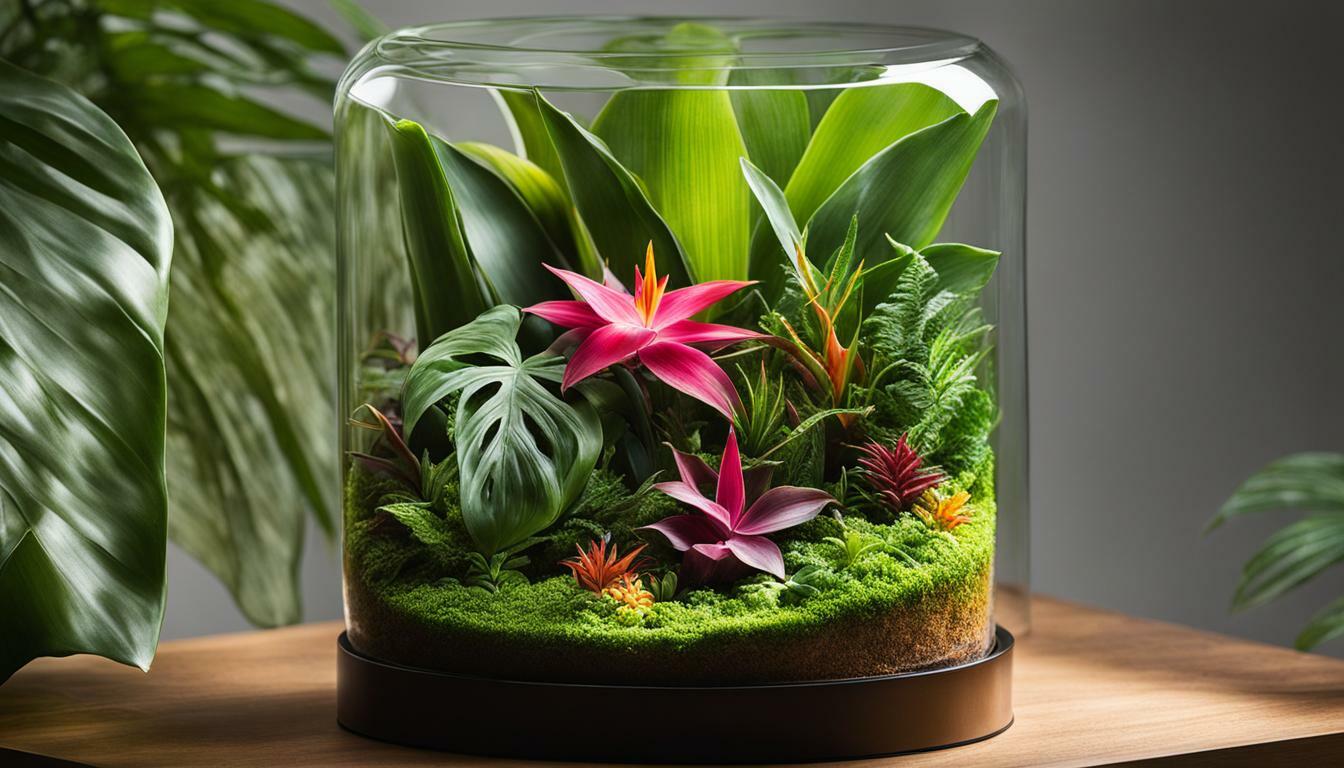Welcome to our expert guide to tropical terrariums, where you will discover how to create and maintain your own lush, green indoor ecosystem and embark on a nature journey like no other.
Creating and maintaining tropical terrariums requires understanding, planning, and skill. The Essential Guide to Tropical Terrariums provides a step-by-step process for building a successful terrarium. The guide covers plant selection, including recommendations for plants that thrive in tropical terrarium conditions. It also offers advice on choosing materials, such as substrate and tools, and provides tips for preparation and construction.
The guide emphasizes the importance of proper care and maintenance, including selecting the right lighting, watering correctly, and routine maintenance. Additionally, terrariums can be made using various containers, such as glass jars or aquariums. The article suggests using closed containers for tropical plants that require high humidity, while open containers are suitable for plants like cacti that prefer drier conditions.
To create a terrarium, a drainage layer of gravel or stones, followed by a layer of activated charcoal, is recommended. Sheet moss should be added on top to prevent mixing with the underlying layers. The next layer consists of sterile potting mix, which creates a base for the plants. When placing the plants, it is advisable to start with the tallest ones and arrange them asymmetrically for a pleasing design. Decorative elements, such as bark chips or figurines, can be added for personalization.
Terrariums should be placed in bright but indirect sunlight, and watering should be done sparingly to avoid overwatering. Regular maintenance includes removing yellowing or damaged leaves, periodic cleaning of the terrarium glass, and avoiding the use of fertilizers to prevent excessive growth.
Key Takeaways:
- Creating and maintaining tropical terrariums requires understanding, planning, and skill.
- Selecting the right plants for your terrarium is essential for success.
- Choosing the correct materials and tools is crucial for proper preparation and construction.
- Proper care and maintenance, including lighting and watering, are vital for the health of the terrarium.
- Regular maintenance tasks like removing yellowing leaves and cleaning the terrarium glass are necessary.
Understanding Tropical Terrariums
To successfully create and maintain tropical terrariums, it is crucial to have a solid understanding of the unique characteristics and requirements of this type of indoor ecosystem, including the selection of humid plant types that mimic the beauty of rainforests and provide an exotic touch to your living space.
Tropical terrariums are designed to recreate the lush and vibrant environment found in rainforests, where humidity levels are high and an abundance of diverse plant life thrives. These indoor ecosystems offer nature enthusiasts the opportunity to bring a piece of the exotic rainforest into their homes, creating a captivating and visually appealing display.
“By carefully selecting plants that thrive in humid conditions, you can recreate the enchanting atmosphere of a rainforest in your own living room.”
Humid plant types are ideal for tropical terrariums as they have evolved to thrive in the warm, moist environment of rainforests. These plants often boast stunning foliage, vibrant colors, and unique shapes, adding an exotic touch to your living space. Some popular choices for humid plant types include ferns, bromeliads, orchids, and mosses.
Humid Plant Types | |
|---|---|
| Ferns | Ferns are well-suited to the high humidity levels of tropical terrariums. Their delicate fronds and intricate patterns add a touch of elegance to any arrangement. |
| Bromeliads | Bromeliads are hardy plants that thrive in humid environments. With their vibrant, long-lasting blooms and striking foliage, they create a tropical oasis within your terrarium. |
| Orchids | Known for their exquisite beauty and variety, orchids are popular choices for tropical terrariums. Their vibrant colors and delicate blooms create a captivating centerpiece. |
| Mosses | Mosses are versatile plants that thrive in moist conditions. They add a lush, green carpet to the base of your terrarium and help maintain moisture levels. |
To enhance the authenticity of your tropical terrarium, consider adding natural elements that mimic the rainforest environment. These can include small stones, pieces of driftwood, or even a miniature waterfall. These additions not only provide aesthetic appeal but also create a more realistic and immersive experience for you and your plants.
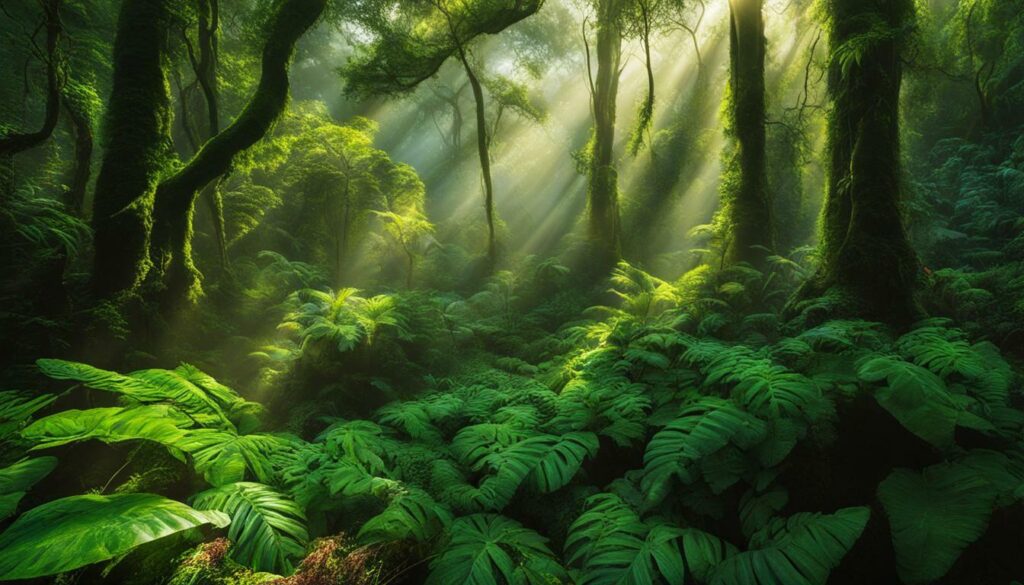
By immersing yourself in the fascinating world of tropical terrariums, you can create a captivating indoor ecosystem that brings the beauty of the rainforest into your own home. With proper knowledge and care, your terrarium will thrive and provide you with endless joy and relaxation.
Plant Selection for Tropical Terrariums
Choosing the right plants is essential for creating a thriving tropical terrarium that can flourish in the specific conditions that mimic their natural habitat. When selecting plants, it is important to consider the unique requirements of tropical terrariums, including humidity, temperature, and lighting. Here are some recommendations for plants that are well-suited to tropical terrarium conditions:
| Plant | Height | Light Requirements | Watering Frequency |
|---|---|---|---|
| Ferns | Varies depending on the species | Low to medium light | Regular watering to keep the soil consistently moist |
| Philodendrons | Varies depending on the species | Medium to bright indirect light | Allow the top inch of soil to dry out between waterings |
| Fittonias | 4-8 inches | Medium to bright indirect light | Water when the top inch of soil is dry |
These are just a few examples of plants that thrive in tropical terrarium conditions. It is important to research and choose plants that have similar care requirements to ensure they will thrive together in the enclosed ecosystem. Additionally, consider the size and growth habit of each plant to ensure they will not overcrowd the terrarium as they mature.
Plant Care Tips:
- Monitor the humidity levels inside the terrarium and adjust as needed to maintain a suitable environment for tropical plants. This can be done by misting the plants with water or using a humidifier.
- Provide adequate airflow to prevent the buildup of excess moisture, which can lead to mold or fungal growth. Opening the terrarium for a short period each day or using a small fan can help improve air circulation.
- Regularly trim and prune the plants to maintain their shape and prevent overcrowding. This will also encourage healthy growth and prevent any one plant from dominating the terrarium.
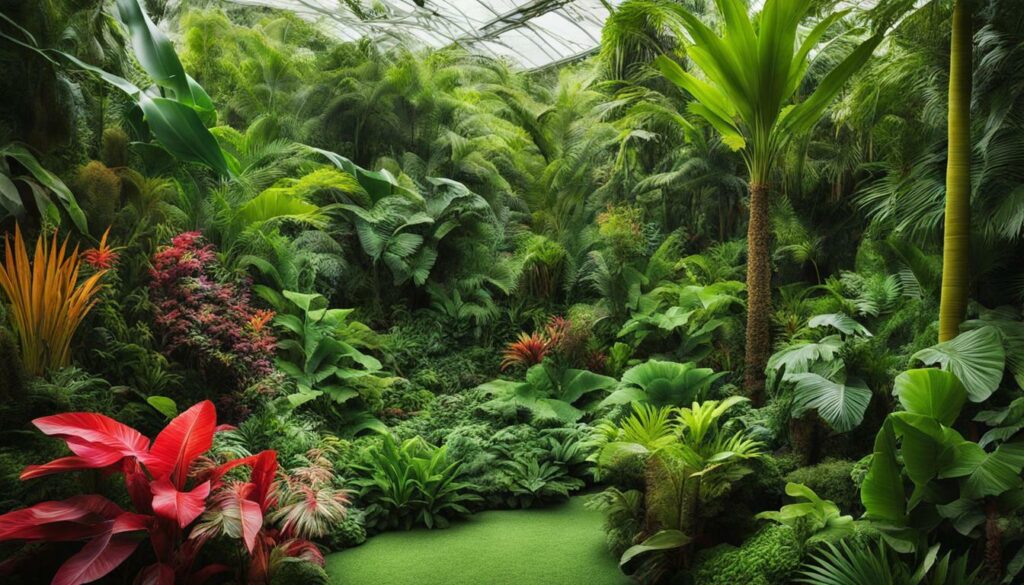
As you build your tropical terrarium, keep in mind that each plant has its own unique care requirements. It is important to regularly monitor and address the specific needs of each plant to ensure their well-being. By carefully selecting and caring for the right plants, you can create a vibrant and thriving tropical ecosystem right in your own home.
Materials and Tools for Tropical Terrariums
Building a successful tropical terrarium requires careful consideration of the materials and tools you’ll need to create the ideal environment for your plants to thrive. From selecting the right substrate to having the necessary tools for preparation and construction, each element plays a crucial role in the overall success of your terrarium project.
In terms of substrate, it’s recommended to use a well-draining mixture that retains moisture while allowing air circulation. A combination of sphagnum moss, orchid bark, and peat moss can create a balanced substrate that provides the necessary nutrients and moisture retention for your tropical plants.
When it comes to tools, having a few essentials on hand will make the process much more efficient. A pair of sharp scissors or pruning shears will come in handy for trimming and grooming your plants. Long-handled tweezers or chopsticks can be used for precise placement of plants and decorative elements. A spray bottle or mister will assist you in watering your terrarium without over-saturating the soil.
To help you get started, we’ve compiled a table summarizing the key materials and tools for building a tropical terrarium:
| Materials | Tools |
|---|---|
| Sphagnum moss | Sharp scissors or pruning shears |
| Orchid bark | Long-handled tweezers or chopsticks |
| Peat moss | Spray bottle or mister |
| Glass container | Soft brush or cloth for cleaning |
| Activated charcoal | Miniature gardening tools |
Remember, the materials and tools listed here are just a starting point. You may find that you need additional items depending on the specific plants and design elements you choose for your tropical terrarium. With the right materials and tools at your disposal, you’ll be well-equipped to embark on your tropical terrarium journey and create a thriving indoor ecosystem.
Step-by-Step Guide to Building a Tropical Terrarium
Building a tropical terrarium is a creative process that involves selecting the right container based on the specific requirements of the plants you plan to nurture in your indoor ecosystem. The container plays a crucial role in providing the ideal conditions for your tropical plants to thrive.
When it comes to terrarium containers, there are two main options to consider: closed containers and open containers. Closed containers are recommended for tropical plants that require high humidity, while open containers are suitable for plants like cacti that prefer drier conditions.
To begin building your tropical terrarium, you’ll need to gather the necessary materials and set up the layers. Start with a drainage layer of gravel or stones at the bottom of your container to ensure proper water flow. A layer of activated charcoal should be added on top to filter and purify the water. Next, place sheet moss over the charcoal to prevent the soil from mixing with the lower layers. Finally, add a layer of sterile potting mix to provide a nutrient-rich base for your plants.
Once the layers are in place, it’s time to arrange your plants. Start with the tallest plants and place them towards the back of the terrarium to create depth. Asymmetric design is recommended for a more natural and visually pleasing arrangement. You can also add decorative elements, such as bark chips or figurines, to add a personal touch to your tropical terrarium.
| Terrarium Container Options | Recommended Plants |
|---|---|
| Closed Containers | – Ferns – Orchids – Bromeliads |
| Open Containers | – Succulents – Cacti – Air plants |
Once your tropical terrarium is set up, it’s important to provide the right care and maintenance. Place the terrarium in a location with bright but indirect sunlight, as direct sunlight can cause overheating. Water sparingly, as tropical plants generally prefer slightly moist soil rather than being overly wet. Regular maintenance includes removing yellowing or damaged leaves, periodically cleaning the terrarium glass to maintain visibility, and avoiding the use of fertilizers to prevent excessive growth.
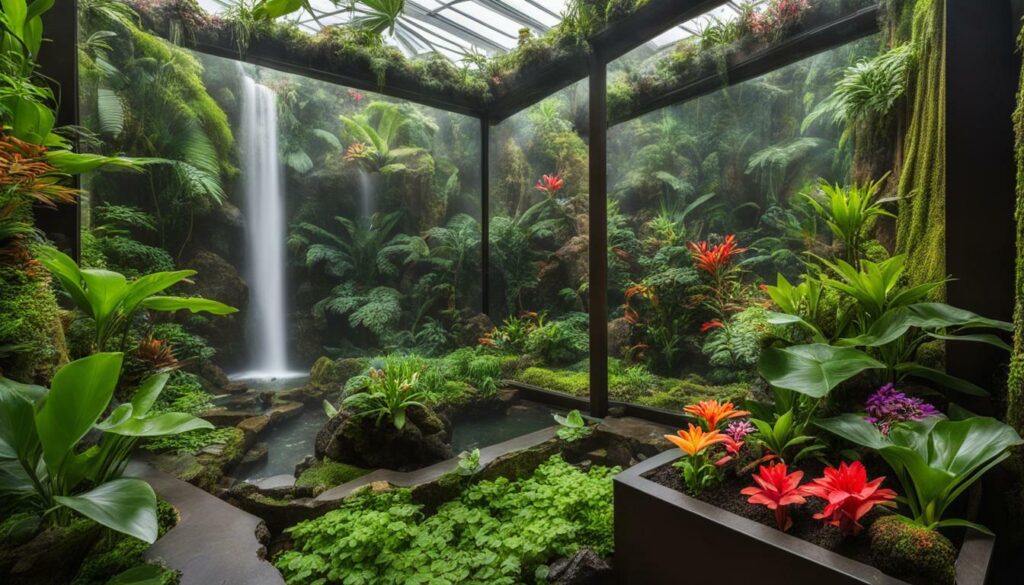
Building and maintaining a tropical terrarium is a rewarding endeavor that allows you to bring the beauty of nature into your home. By carefully selecting the right container, arranging the plants thoughtfully, and providing proper care, you can create an enchanting and thriving indoor ecosystem that will bring joy and serenity to your surroundings.
Layers and Setup of a Tropical Terrarium
The layers and setup of a tropical terrarium play a crucial role in providing the necessary support and environment for the plants to thrive. When constructing your terrarium, it is important to follow a systematic approach to ensure the proper functioning of the ecosystem.
1. Drainage Layer: The first layer consists of a drainage material such as gravel or stones. This layer helps prevent water from accumulating at the bottom of the terrarium, which can lead to root rot. It allows excess water to drain away, maintaining a balanced moisture level within the terrarium.
2. Activated Charcoal: After the drainage layer, a layer of activated charcoal is added. Activated charcoal acts as a natural filter, removing impurities and keeping the terrarium ecosystem clean and healthy. It also helps to control odors and prevents the growth of harmful bacteria.
| Layer | Material | Function |
|---|---|---|
| 1 | Drainage Layer | Prevents water accumulation and root rot |
| 2 | Activated Charcoal | Filters impurities, controls odors, and prevents bacterial growth |
| 3 | Sheet Moss | Prevents mixing of layers and retains moisture |
| 4 | Potting Mix | Provides a stable base for plant growth |
3. Sheet Moss: Adding a layer of sheet moss on top of the activated charcoal helps prevent the mixing of layers. It acts as a natural barrier, ensuring that the potting mix stays in place while still allowing water to permeate through. Sheet moss also helps retain moisture, creating a humid microclimate that is beneficial for tropical plants.
4. Potting Mix: The final layer is the potting mix, which serves as the foundation for the plants. It provides essential nutrients, aeration, and drainage for roots to grow and thrive. It is important to use a sterile potting mix specifically formulated for terrariums to prevent the introduction of pests or diseases.
By following the correct layering and setup process, you can create a stable and balanced environment for your tropical terrarium plants. Remember to choose plants that are suitable for the specific conditions of your terrarium, and regularly monitor and adjust watering and lighting to ensure the optimal growth of your indoor ecosystem.
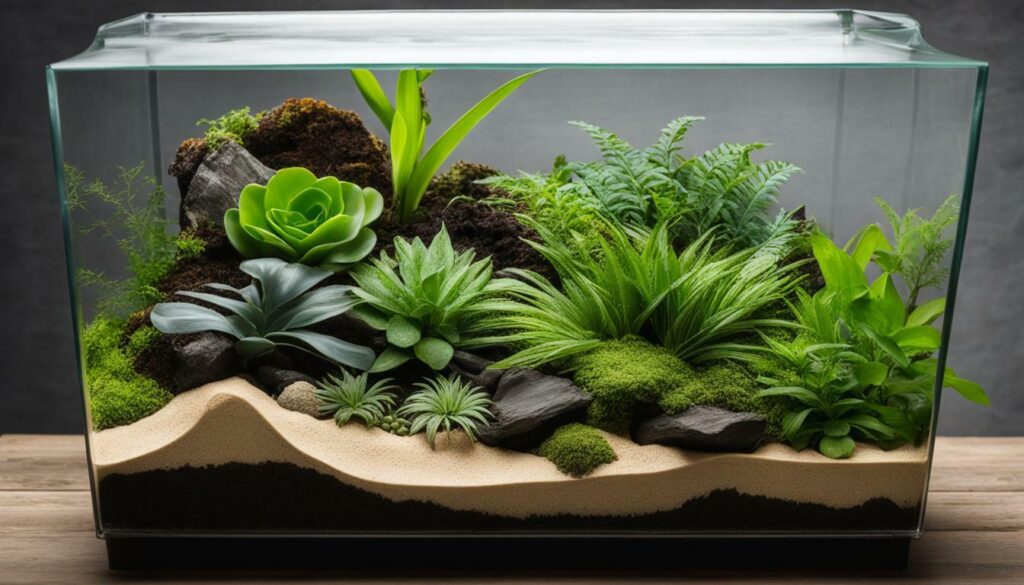
The arrangement of plants in a tropical terrarium is not only a matter of aesthetic appeal but also contributes to the overall functionality and health of the ecosystem. When creating your tropical terrarium, it is important to consider the growth habits and light requirements of the plants you choose. Starting with tall plants allows for a visually striking composition, adding depth and dimension to your terrarium. Asymmetric design, where plants are arranged in an irregular pattern, creates a more natural and dynamic landscape within the terrarium.
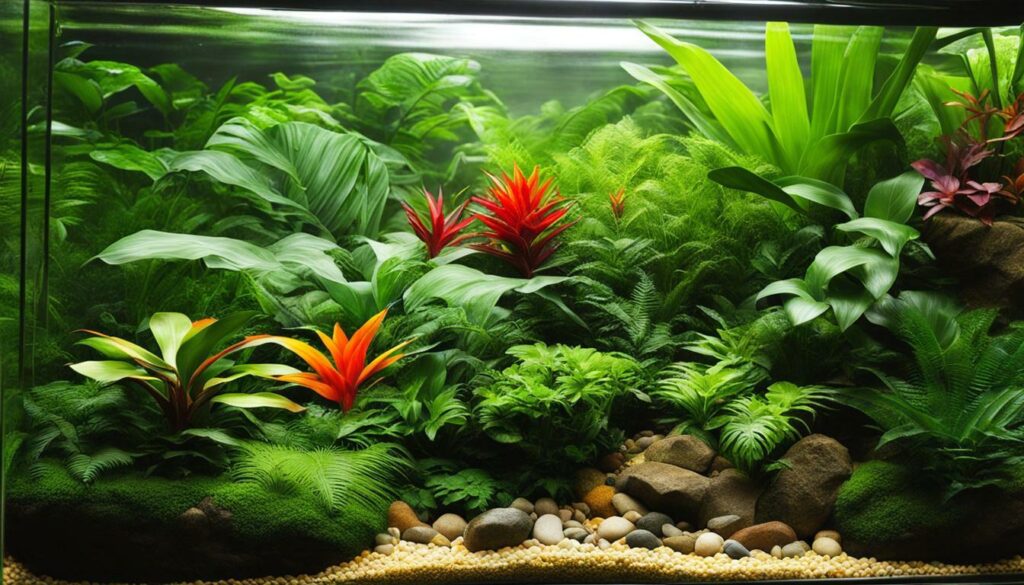
Personalization is another aspect that adds a unique touch to your tropical terrarium. Consider incorporating decorative elements such as bark chips, small figurines, or natural stones to enhance the visual appeal and create a miniaturized world within the terrarium. These elements can also provide hiding spots or perches for small creatures like frogs or lizards that may inhabit the ecosystem. Be mindful, however, not to overcrowd the terrarium, as ample space is necessary for plant growth and to maintain proper airflow.
| Plant | Light Requirements | Watering Needs |
|---|---|---|
| Alocasia | Bright indirect light | Keep soil evenly moist |
| Bromeliads | Bright, filtered light | Mist or water the central rosette |
| Ferns | Indirect light, shade-tolerant | Keep soil consistently moist |
Remember to periodically rotate your tropical terrarium to ensure even sunlight exposure for all plants. This will also help prevent excessive growth towards one side. With careful planning and attention to detail, you can create a unique and thriving tropical oasis in your own home.
Care and Maintenance of Tropical Terrariums
Caring for and maintaining a tropical terrarium requires attention to key factors such as lighting, watering, and routine maintenance to create an optimal environment for your plants to thrive. Proper lighting is crucial for the growth and development of tropical plants. Choose a location for your terrarium that provides bright but indirect sunlight. This will mimic the dappled light found in the rainforest, where many tropical plants naturally thrive. If natural light is insufficient, consider using artificial grow lights to supplement the lighting needs of your terrarium.
Watering is another essential aspect of tropical terrarium care. While it’s important to keep the soil moist, overwatering can lead to root rot and other issues. The best way to determine when to water is by checking the moisture level of the soil. Stick your finger about an inch into the soil and if it feels dry, it’s time to water. Use a spray bottle or a watering can with a fine nozzle to gently moisten the soil, taking care to avoid saturating the plants or creating standing water in the terrarium.
Routine maintenance is necessary to keep your tropical terrarium healthy and thriving. Regularly inspect the plants for any yellowing or damaged leaves and remove them promptly to maintain the overall appearance and health of the terrarium. Cleaning the terrarium glass from time to time will ensure optimal light transmission and allow you to fully enjoy the lush greenery within. When cleaning, use a soft cloth or sponge and mild soapy water, being careful not to disturb the plants or wet the soil excessively. Lastly, it’s important to note that tropical plants generally do not require fertilizers within the controlled environment of a terrarium. The nutrients present in the potting mix are typically sufficient for their growth, and excessive fertilizer application can lead to overgrowth and imbalance within the ecosystem.
Lighting, Watering, and Routine Maintenance
Creating and maintaining optimal lighting, providing appropriate watering, and adhering to routine maintenance are key factors in ensuring the long-term success of your tropical terrarium. By understanding the specific needs of your plants and following these guidelines, you can create a thriving ecosystem that brings the beauty of nature into your home. Remember, each terrarium is unique, and regular observation and adjustments are necessary to meet the requirements of your individual plants.
| Lighting Tips for Tropical Terrariums | |
|---|---|
| 1. | Place your terrarium in a bright but indirect sunlight location. |
| 2. | Consider using artificial grow lights to supplement natural lighting, if needed. |
| Watering Guidelines for Tropical Terrariums | |
|---|---|
| 1. | Check the moisture level of the soil by sticking your finger about an inch deep. |
| 2. | Water when the soil feels dry, using a spray bottle or watering can with a fine nozzle. |
| 3. | Avoid overwatering and creating standing water to prevent root rot. |
Providing appropriate lighting and watering are crucial for the health and growth of your tropical terrarium. It’s important to strike the right balance between light and moisture to create a thriving ecosystem for your plants.
- Regularly inspect the plants for yellowing or damaged leaves and remove them promptly.
- Clean the terrarium glass periodically with mild soapy water and a soft cloth or sponge.
- Avoid using fertilizers as the nutrients present in the potting mix are usually sufficient for tropical plants.
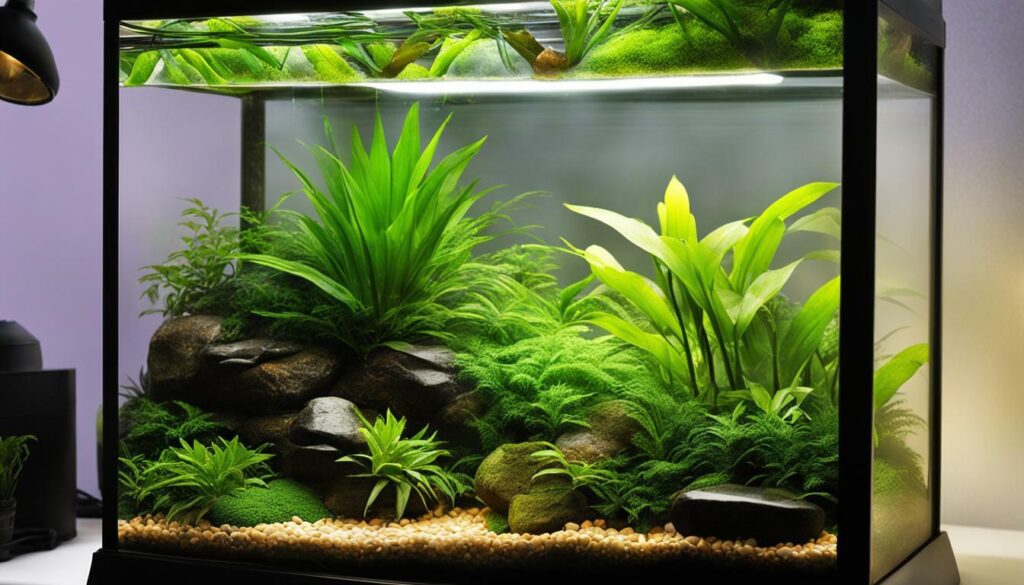
In summary, proper care and maintenance, including providing adequate lighting, watering correctly, and adhering to routine tasks, are essential for the success of your tropical terrarium. By understanding and meeting the specific needs of your plants, you can create a vibrant and thriving indoor ecosystem that brings the beauty of the tropics into your home.
Regular Maintenance Tips for Tropical Terrariums
Regular maintenance is essential for the long-term health and beauty of your tropical terrarium, and by following these tips, you can ensure your indoor ecosystem remains vibrant and well-maintained. Here are some key practices to keep in mind:
- Removing yellowing or damaged leaves: Inspect your plants regularly and remove any yellowing or damaged leaves promptly. This helps maintain the overall aesthetics of the terrarium and prevents the spread of diseases or pests.
- Cleaning the terrarium glass: Over time, the terrarium glass can accumulate dust, water spots, or algae. To keep the glass clear and transparent, gently wipe it with a soft cloth or use a glass cleaner specifically designed for terrariums. Avoid using harsh chemicals that may harm your plants.
- Avoiding the use of fertilizers: Unlike outdoor gardens, tropical terrariums are self-contained ecosystems that don’t require additional fertilization. In fact, excessive use of fertilizers can lead to overgrowth and damage to the delicate balance of the terrarium. Instead, rely on the nutrients provided by the potting mix and the natural breakdown of organic matter.
By implementing these regular maintenance practices, you can ensure the longevity and vitality of your tropical terrarium. With proper care, your indoor ecosystem will continue to thrive and provide you with the joy and beauty of a miniature rainforest.
Table: Maintenance Checklist
| Task | Frequency |
|---|---|
| Inspect and remove yellowing or damaged leaves | Weekly |
| Clean terrarium glass | Monthly |
| Avoid the use of fertilizers | Ongoing |
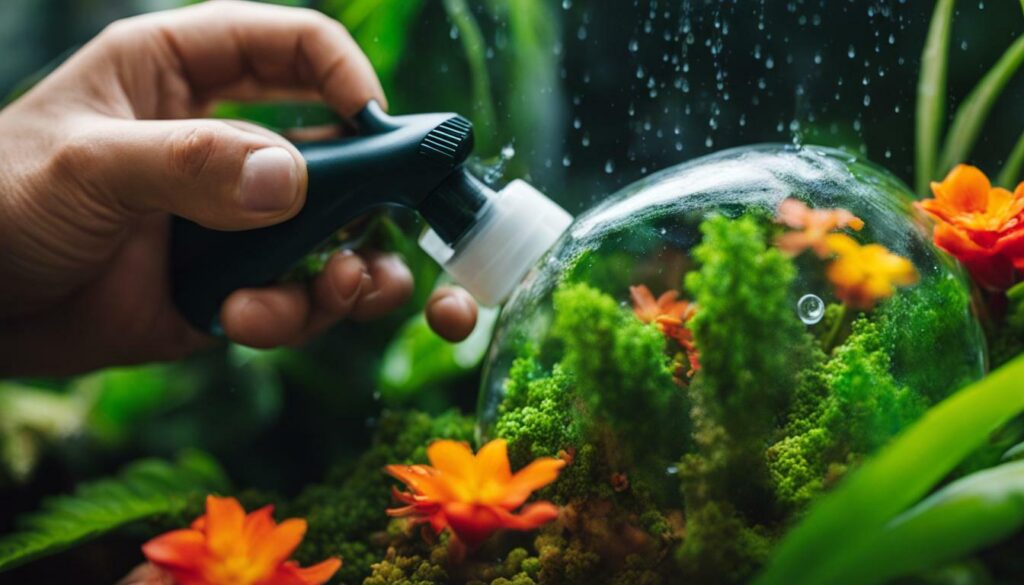
“By implementing these regular maintenance practices, you can ensure the longevity and vitality of your tropical terrarium. With proper care, your indoor ecosystem will continue to thrive and provide you with the joy and beauty of a miniature rainforest.”
Conclusion
Creating and maintaining a tropical terrarium offers a unique opportunity to cultivate your own slice of lush, green paradise indoors, bringing nature’s beauty and tranquility into your everyday life. The Essential Guide to Tropical Terrariums provides a comprehensive step-by-step process for building a successful terrarium, whether you’re a seasoned plant enthusiast or just beginning your nature journey.
In this guide, we have explored the importance of understanding tropical terrariums and the types of plants that thrive in these environments. We have provided recommendations for plant selection, highlighting those that are best suited for tropical terrarium conditions. We have also discussed the essential materials and tools needed for proper terrarium construction, emphasizing the significance of selecting the right substrate and preparing the terrarium foundation.
Care and maintenance are crucial for the long-term health and longevity of your tropical terrarium. The guide offers valuable insights on selecting the right lighting, watering techniques, and routine maintenance to ensure your plants thrive within their enclosed ecosystem. Additionally, we have shared regular maintenance tips such as removing yellowing or damaged leaves, cleaning the terrarium glass, and avoiding the use of fertilizers to prevent excessive growth.
When creating your tropical terrarium, consider using different containers to suit the needs of your plants. Closed containers are ideal for tropical plants that require high humidity, while open containers are suitable for plants like cacti that prefer drier conditions. As you arrange your plants, start with the tallest ones and arrange them asymmetrically to create a visually pleasing design. Finally, personalize your terrarium with decorative elements such as bark chips or figurines.
In conclusion, the art of creating and maintaining a tropical terrarium allows you to bring the beauty of the natural world into your home. With the right knowledge and attention to detail, you can create a vibrant and thriving indoor ecosystem that will bring you joy and tranquility for years to come.
Can the same principles for creating and maintaining a tropical terrarium be applied to DIY terrariums?
Yes, the same principles for creating and maintaining a tropical terrarium can be applied to DIY terrariums. Whether it’s choosing the right plants, ensuring proper drainage, or creating a suitable environment, the process remains the same. With the right materials and knowledge, you can create your miniature world effortlessly.
FAQ
What is the Essential Guide to Tropical Terrariums?
The Essential Guide to Tropical Terrariums is a comprehensive resource that provides step-by-step instructions and tips for creating and maintaining successful tropical terrariums.
What does the guide cover?
The guide covers various aspects of tropical terrariums, including plant selection, choosing materials and tools, preparation and construction, care and maintenance, and regular maintenance tips.
What types of plants thrive in tropical terrarium conditions?
The guide provides recommendations for plants that thrive in tropical terrarium conditions, including those that require high humidity and those that prefer drier conditions.
What types of containers can be used for tropical terrariums?
Terrariums can be made using various containers, such as glass jars or aquariums. Closed containers are suitable for tropical plants that require high humidity, while open containers are suitable for plants that prefer drier conditions.
What is the recommended setup for a tropical terrarium?
The recommended setup includes a drainage layer of gravel or stones, followed by a layer of activated charcoal. Sheet moss should be added on top to prevent mixing with the underlying layers. The next layer consists of sterile potting mix, which creates a base for the plants.
How should plants be arranged in a tropical terrarium?
It is advisable to start with the tallest plants and arrange them asymmetrically for a pleasing design.
What care and maintenance is required for tropical terrariums?
Proper care and maintenance for tropical terrariums include selecting the right lighting, watering correctly, and routine maintenance such as removing yellowing or damaged leaves and periodic cleaning of the terrarium glass.
Should fertilizers be used in tropical terrariums?
It is recommended to avoid using fertilizers in tropical terrariums to prevent excessive growth.

